Taxation Analysis Report
VerifiedAdded on 2020/03/28
|12
|2441
|39
Report
AI Summary
This report provides a comprehensive analysis of various taxation issues, including capital gains, fringe benefits, and the implications of specific tax rulings under Australian law. It discusses the application of the Income Tax Assessment Act (ITAA) 1997 and relevant case studies, offering insights into tax compliance and the legal framework governing taxation in Australia.
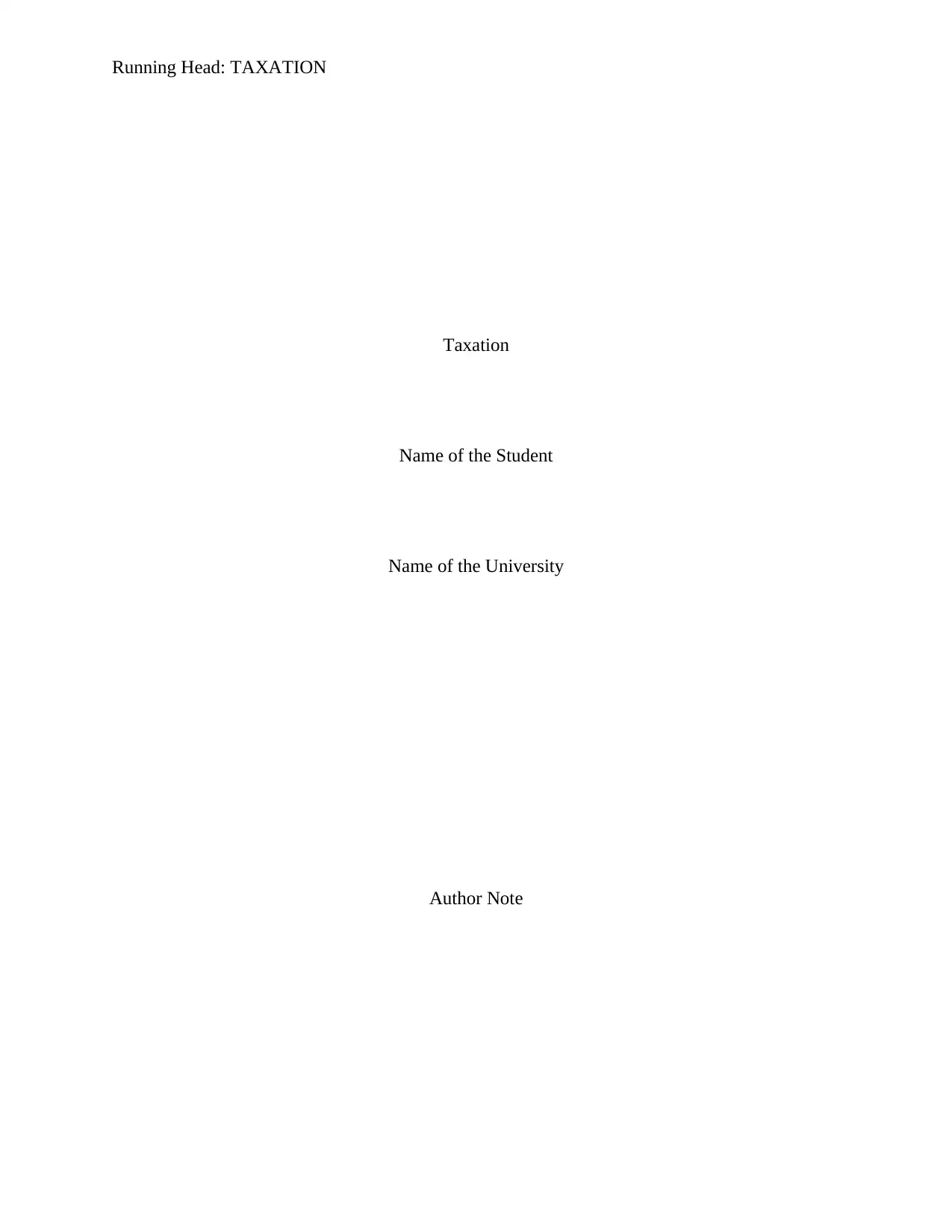
Running Head: TAXATION
Taxation
Name of the Student
Name of the University
Author Note
Taxation
Name of the Student
Name of the University
Author Note
Paraphrase This Document
Need a fresh take? Get an instant paraphrase of this document with our AI Paraphraser
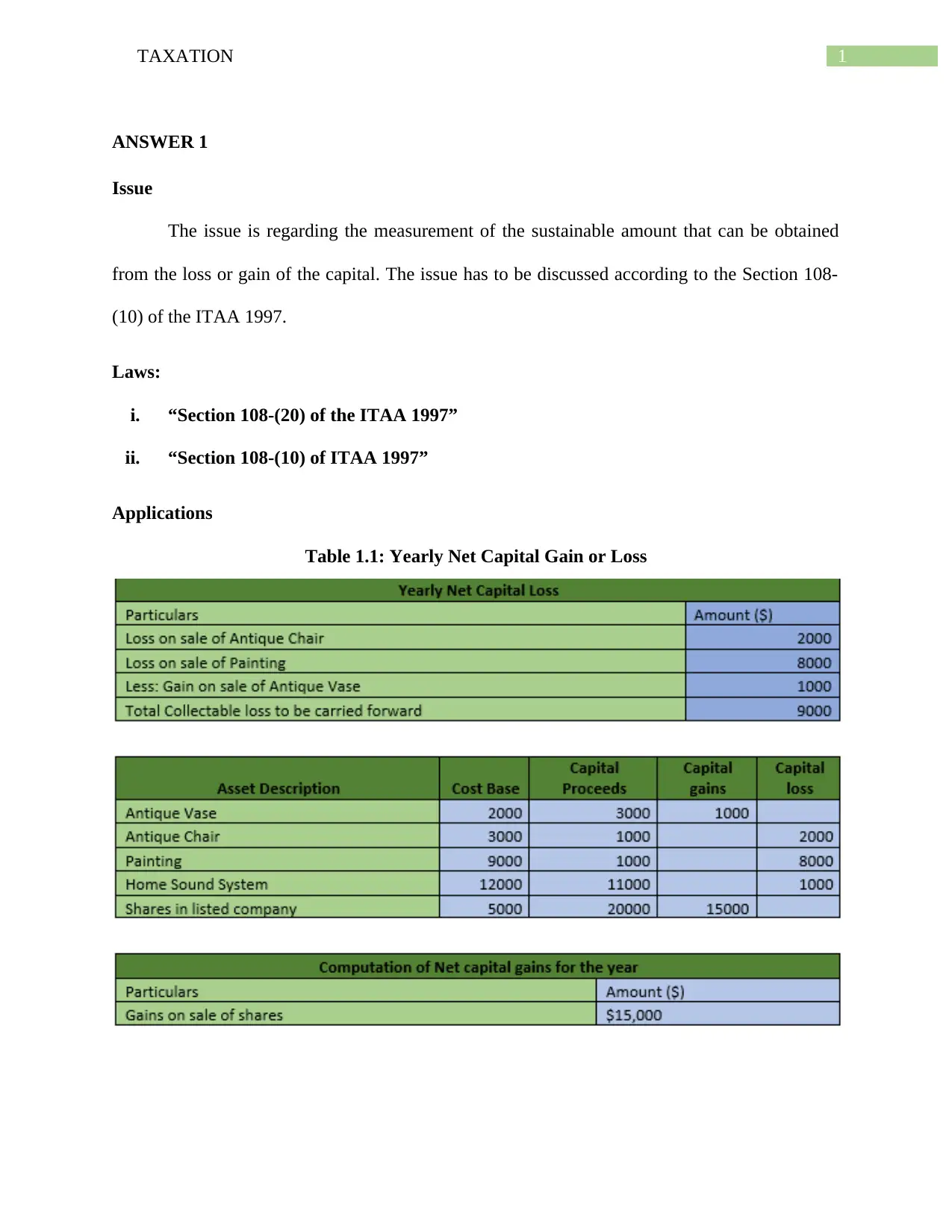
1TAXATION
ANSWER 1
Issue
The issue is regarding the measurement of the sustainable amount that can be obtained
from the loss or gain of the capital. The issue has to be discussed according to the Section 108-
(10) of the ITAA 1997.
Laws:
i. “Section 108-(20) of the ITAA 1997”
ii. “Section 108-(10) of ITAA 1997”
Applications
Table 1.1: Yearly Net Capital Gain or Loss
ANSWER 1
Issue
The issue is regarding the measurement of the sustainable amount that can be obtained
from the loss or gain of the capital. The issue has to be discussed according to the Section 108-
(10) of the ITAA 1997.
Laws:
i. “Section 108-(20) of the ITAA 1997”
ii. “Section 108-(10) of ITAA 1997”
Applications
Table 1.1: Yearly Net Capital Gain or Loss
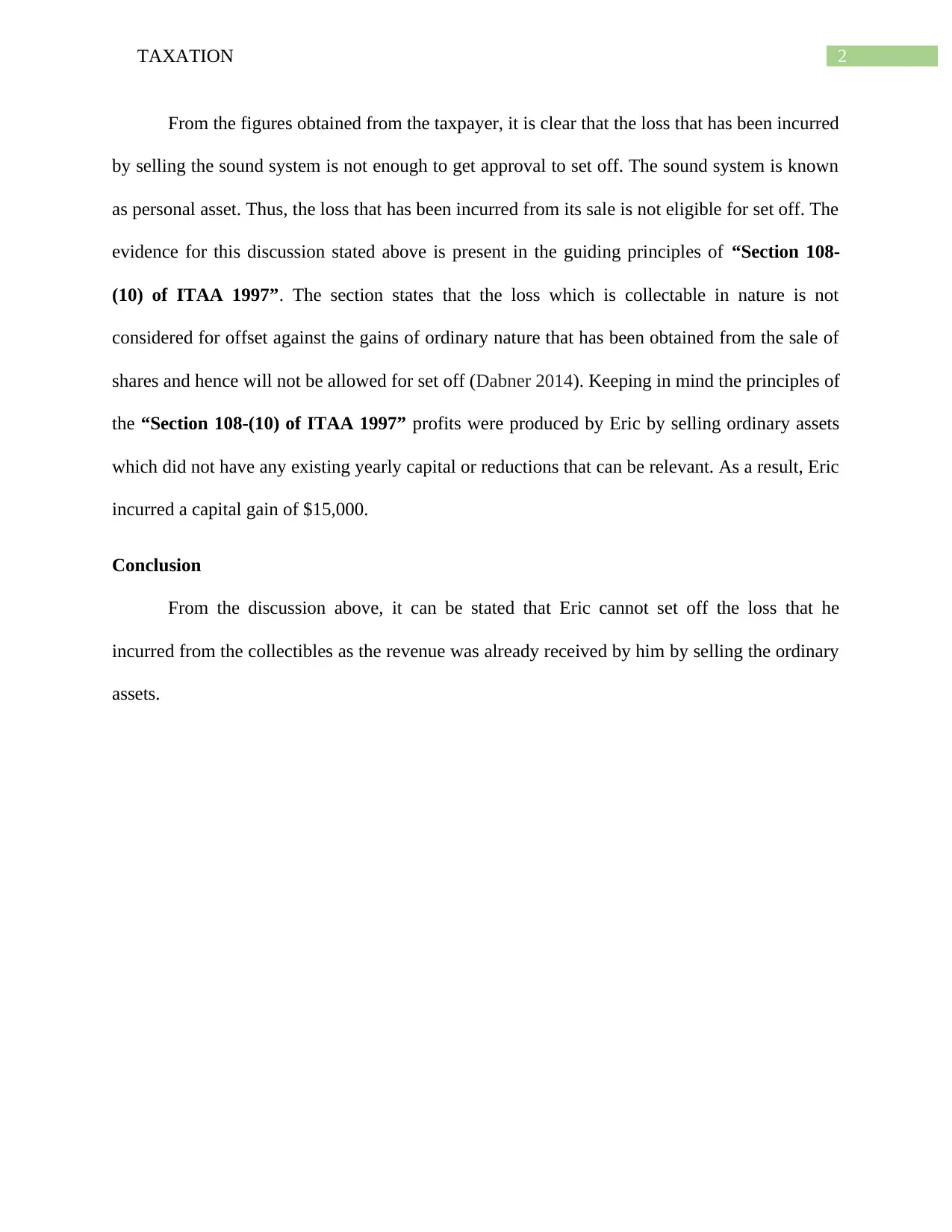
2TAXATION
From the figures obtained from the taxpayer, it is clear that the loss that has been incurred
by selling the sound system is not enough to get approval to set off. The sound system is known
as personal asset. Thus, the loss that has been incurred from its sale is not eligible for set off. The
evidence for this discussion stated above is present in the guiding principles of “Section 108-
(10) of ITAA 1997”. The section states that the loss which is collectable in nature is not
considered for offset against the gains of ordinary nature that has been obtained from the sale of
shares and hence will not be allowed for set off (Dabner 2014). Keeping in mind the principles of
the “Section 108-(10) of ITAA 1997” profits were produced by Eric by selling ordinary assets
which did not have any existing yearly capital or reductions that can be relevant. As a result, Eric
incurred a capital gain of $15,000.
Conclusion
From the discussion above, it can be stated that Eric cannot set off the loss that he
incurred from the collectibles as the revenue was already received by him by selling the ordinary
assets.
From the figures obtained from the taxpayer, it is clear that the loss that has been incurred
by selling the sound system is not enough to get approval to set off. The sound system is known
as personal asset. Thus, the loss that has been incurred from its sale is not eligible for set off. The
evidence for this discussion stated above is present in the guiding principles of “Section 108-
(10) of ITAA 1997”. The section states that the loss which is collectable in nature is not
considered for offset against the gains of ordinary nature that has been obtained from the sale of
shares and hence will not be allowed for set off (Dabner 2014). Keeping in mind the principles of
the “Section 108-(10) of ITAA 1997” profits were produced by Eric by selling ordinary assets
which did not have any existing yearly capital or reductions that can be relevant. As a result, Eric
incurred a capital gain of $15,000.
Conclusion
From the discussion above, it can be stated that Eric cannot set off the loss that he
incurred from the collectibles as the revenue was already received by him by selling the ordinary
assets.
⊘ This is a preview!⊘
Do you want full access?
Subscribe today to unlock all pages.

Trusted by 1+ million students worldwide
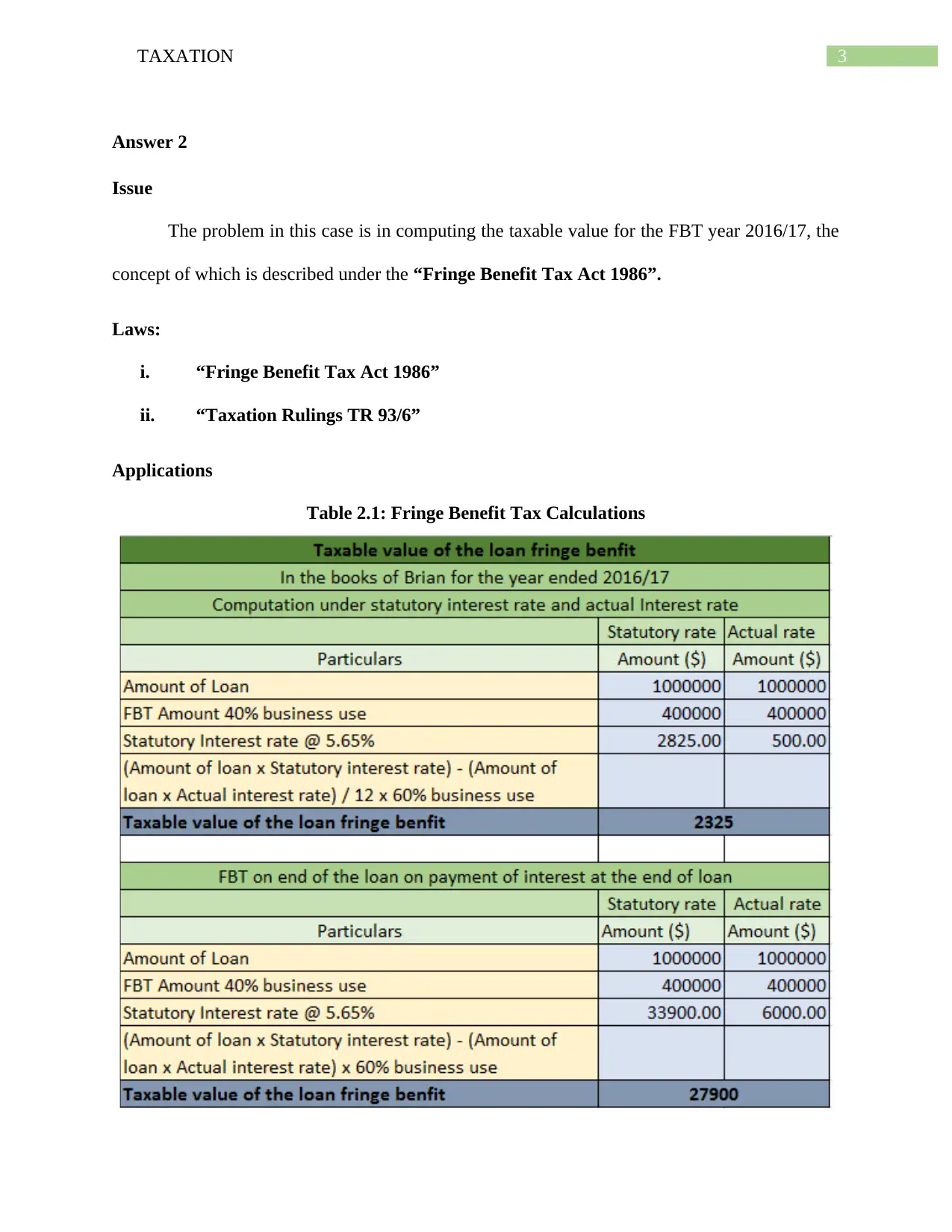
3TAXATION
Answer 2
Issue
The problem in this case is in computing the taxable value for the FBT year 2016/17, the
concept of which is described under the “Fringe Benefit Tax Act 1986”.
Laws:
i. “Fringe Benefit Tax Act 1986”
ii. “Taxation Rulings TR 93/6”
Applications
Table 2.1: Fringe Benefit Tax Calculations
Answer 2
Issue
The problem in this case is in computing the taxable value for the FBT year 2016/17, the
concept of which is described under the “Fringe Benefit Tax Act 1986”.
Laws:
i. “Fringe Benefit Tax Act 1986”
ii. “Taxation Rulings TR 93/6”
Applications
Table 2.1: Fringe Benefit Tax Calculations
Paraphrase This Document
Need a fresh take? Get an instant paraphrase of this document with our AI Paraphraser
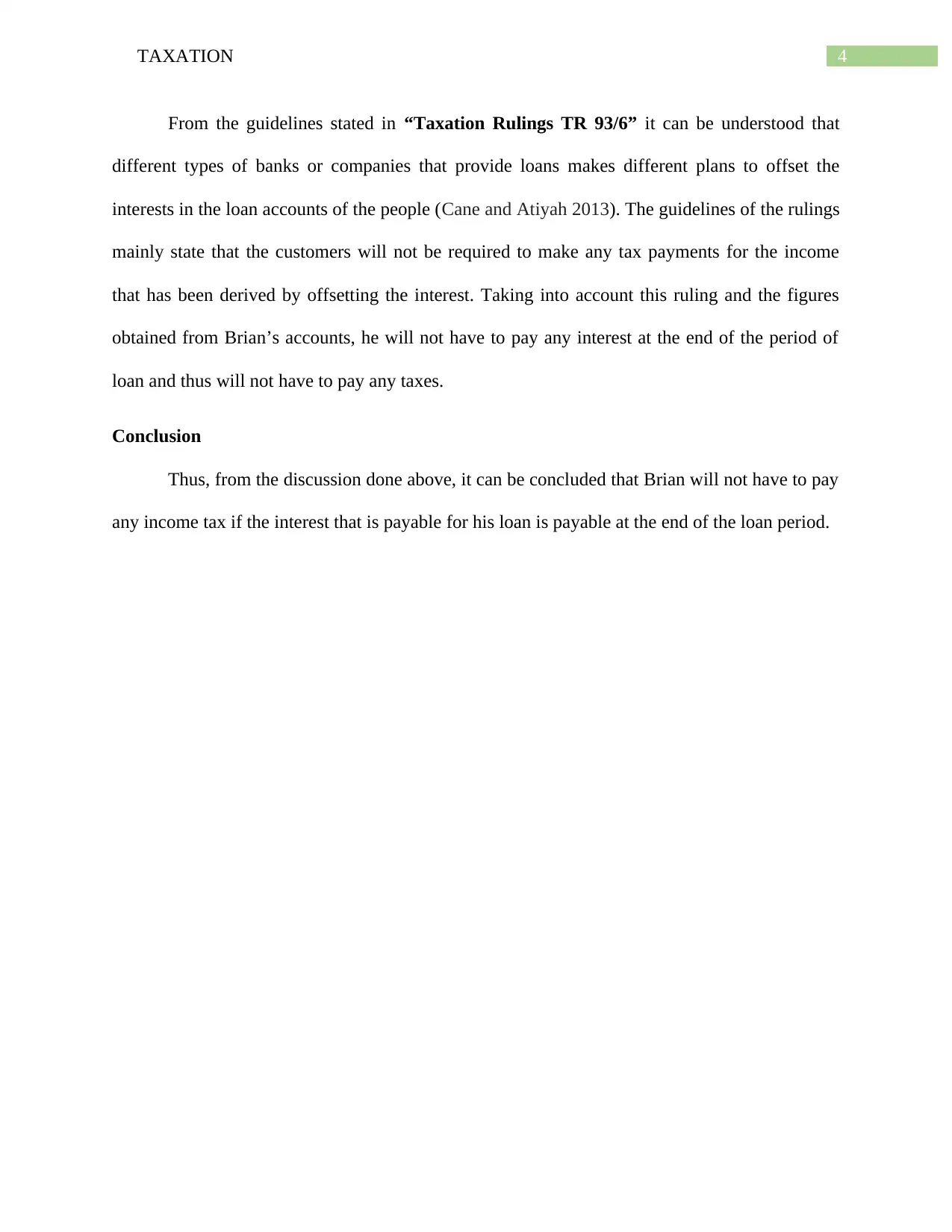
4TAXATION
From the guidelines stated in “Taxation Rulings TR 93/6” it can be understood that
different types of banks or companies that provide loans makes different plans to offset the
interests in the loan accounts of the people (Cane and Atiyah 2013). The guidelines of the rulings
mainly state that the customers will not be required to make any tax payments for the income
that has been derived by offsetting the interest. Taking into account this ruling and the figures
obtained from Brian’s accounts, he will not have to pay any interest at the end of the period of
loan and thus will not have to pay any taxes.
Conclusion
Thus, from the discussion done above, it can be concluded that Brian will not have to pay
any income tax if the interest that is payable for his loan is payable at the end of the loan period.
From the guidelines stated in “Taxation Rulings TR 93/6” it can be understood that
different types of banks or companies that provide loans makes different plans to offset the
interests in the loan accounts of the people (Cane and Atiyah 2013). The guidelines of the rulings
mainly state that the customers will not be required to make any tax payments for the income
that has been derived by offsetting the interest. Taking into account this ruling and the figures
obtained from Brian’s accounts, he will not have to pay any interest at the end of the period of
loan and thus will not have to pay any taxes.
Conclusion
Thus, from the discussion done above, it can be concluded that Brian will not have to pay
any income tax if the interest that is payable for his loan is payable at the end of the loan period.

5TAXATION
Answer 3
Issue
The issue described in this question relates to the loss distribution, which the taxpayers
incur from joint ownership of rental property.
Laws:
i. “FC of T v McDonald”
ii. “Section 51 of the ITAA 1997”
iii. “Taxation ruling TR 93/23”
Applications
The guidelines described in “Taxation Ruling TR 93/32”, the income tax division or any
kind of loss that has been incurred from a rented property amongst the joint owners of the
property has been described (Althaus, Bridgman and Davis 2012). However, the ruling described
above states that rule for judging the measurable position of the co-owners which cannot be
considered valid for running a business within the defined curriculum. Thus, in this case the
assessable positions of Jack and Jill are measured from the property that they have rented. It has
been observed that the Jack will be earning 10% of the profit and his wife Jill will be earning the
remaining 90% of the profit from their rented property.
According to the TR 92/32 ruling, joint ownership can be indicated as a partnership
business which will influence the income tax to be paid by a taxpayer. The idea of the general
law defines that income tax is not concerned with partnership (Althaus, Bridgman and Davis
2012). This concept of joint ownership in any kind of business is not considered in paying the
income taxes. If the company suffers from a loss in income from the property that is rented, then
Answer 3
Issue
The issue described in this question relates to the loss distribution, which the taxpayers
incur from joint ownership of rental property.
Laws:
i. “FC of T v McDonald”
ii. “Section 51 of the ITAA 1997”
iii. “Taxation ruling TR 93/23”
Applications
The guidelines described in “Taxation Ruling TR 93/32”, the income tax division or any
kind of loss that has been incurred from a rented property amongst the joint owners of the
property has been described (Althaus, Bridgman and Davis 2012). However, the ruling described
above states that rule for judging the measurable position of the co-owners which cannot be
considered valid for running a business within the defined curriculum. Thus, in this case the
assessable positions of Jack and Jill are measured from the property that they have rented. It has
been observed that the Jack will be earning 10% of the profit and his wife Jill will be earning the
remaining 90% of the profit from their rented property.
According to the TR 92/32 ruling, joint ownership can be indicated as a partnership
business which will influence the income tax to be paid by a taxpayer. The idea of the general
law defines that income tax is not concerned with partnership (Althaus, Bridgman and Davis
2012). This concept of joint ownership in any kind of business is not considered in paying the
income taxes. If the company suffers from a loss in income from the property that is rented, then
⊘ This is a preview!⊘
Do you want full access?
Subscribe today to unlock all pages.

Trusted by 1+ million students worldwide
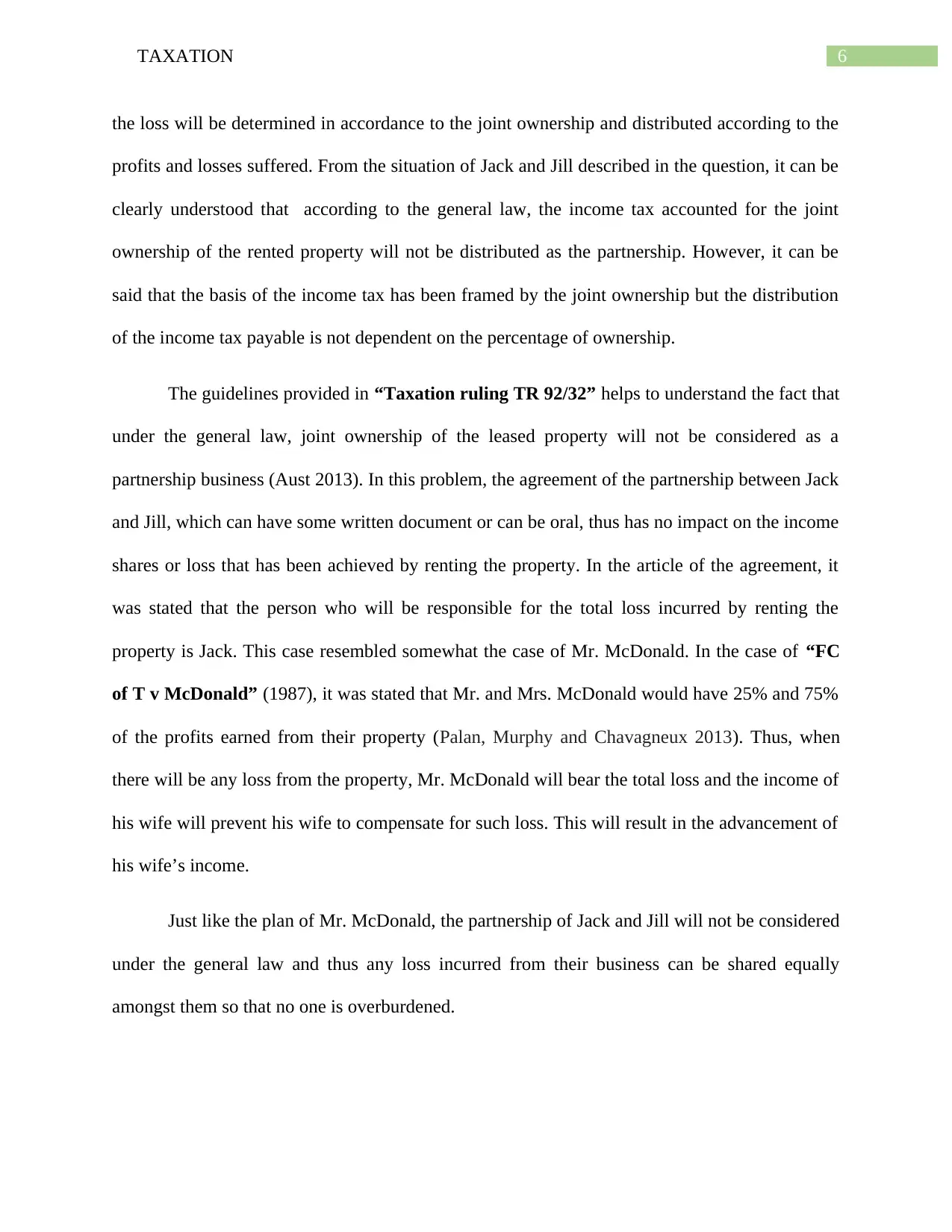
6TAXATION
the loss will be determined in accordance to the joint ownership and distributed according to the
profits and losses suffered. From the situation of Jack and Jill described in the question, it can be
clearly understood that according to the general law, the income tax accounted for the joint
ownership of the rented property will not be distributed as the partnership. However, it can be
said that the basis of the income tax has been framed by the joint ownership but the distribution
of the income tax payable is not dependent on the percentage of ownership.
The guidelines provided in “Taxation ruling TR 92/32” helps to understand the fact that
under the general law, joint ownership of the leased property will not be considered as a
partnership business (Aust 2013). In this problem, the agreement of the partnership between Jack
and Jill, which can have some written document or can be oral, thus has no impact on the income
shares or loss that has been achieved by renting the property. In the article of the agreement, it
was stated that the person who will be responsible for the total loss incurred by renting the
property is Jack. This case resembled somewhat the case of Mr. McDonald. In the case of “FC
of T v McDonald” (1987), it was stated that Mr. and Mrs. McDonald would have 25% and 75%
of the profits earned from their property (Palan, Murphy and Chavagneux 2013). Thus, when
there will be any loss from the property, Mr. McDonald will bear the total loss and the income of
his wife will prevent his wife to compensate for such loss. This will result in the advancement of
his wife’s income.
Just like the plan of Mr. McDonald, the partnership of Jack and Jill will not be considered
under the general law and thus any loss incurred from their business can be shared equally
amongst them so that no one is overburdened.
the loss will be determined in accordance to the joint ownership and distributed according to the
profits and losses suffered. From the situation of Jack and Jill described in the question, it can be
clearly understood that according to the general law, the income tax accounted for the joint
ownership of the rented property will not be distributed as the partnership. However, it can be
said that the basis of the income tax has been framed by the joint ownership but the distribution
of the income tax payable is not dependent on the percentage of ownership.
The guidelines provided in “Taxation ruling TR 92/32” helps to understand the fact that
under the general law, joint ownership of the leased property will not be considered as a
partnership business (Aust 2013). In this problem, the agreement of the partnership between Jack
and Jill, which can have some written document or can be oral, thus has no impact on the income
shares or loss that has been achieved by renting the property. In the article of the agreement, it
was stated that the person who will be responsible for the total loss incurred by renting the
property is Jack. This case resembled somewhat the case of Mr. McDonald. In the case of “FC
of T v McDonald” (1987), it was stated that Mr. and Mrs. McDonald would have 25% and 75%
of the profits earned from their property (Palan, Murphy and Chavagneux 2013). Thus, when
there will be any loss from the property, Mr. McDonald will bear the total loss and the income of
his wife will prevent his wife to compensate for such loss. This will result in the advancement of
his wife’s income.
Just like the plan of Mr. McDonald, the partnership of Jack and Jill will not be considered
under the general law and thus any loss incurred from their business can be shared equally
amongst them so that no one is overburdened.
Paraphrase This Document
Need a fresh take? Get an instant paraphrase of this document with our AI Paraphraser
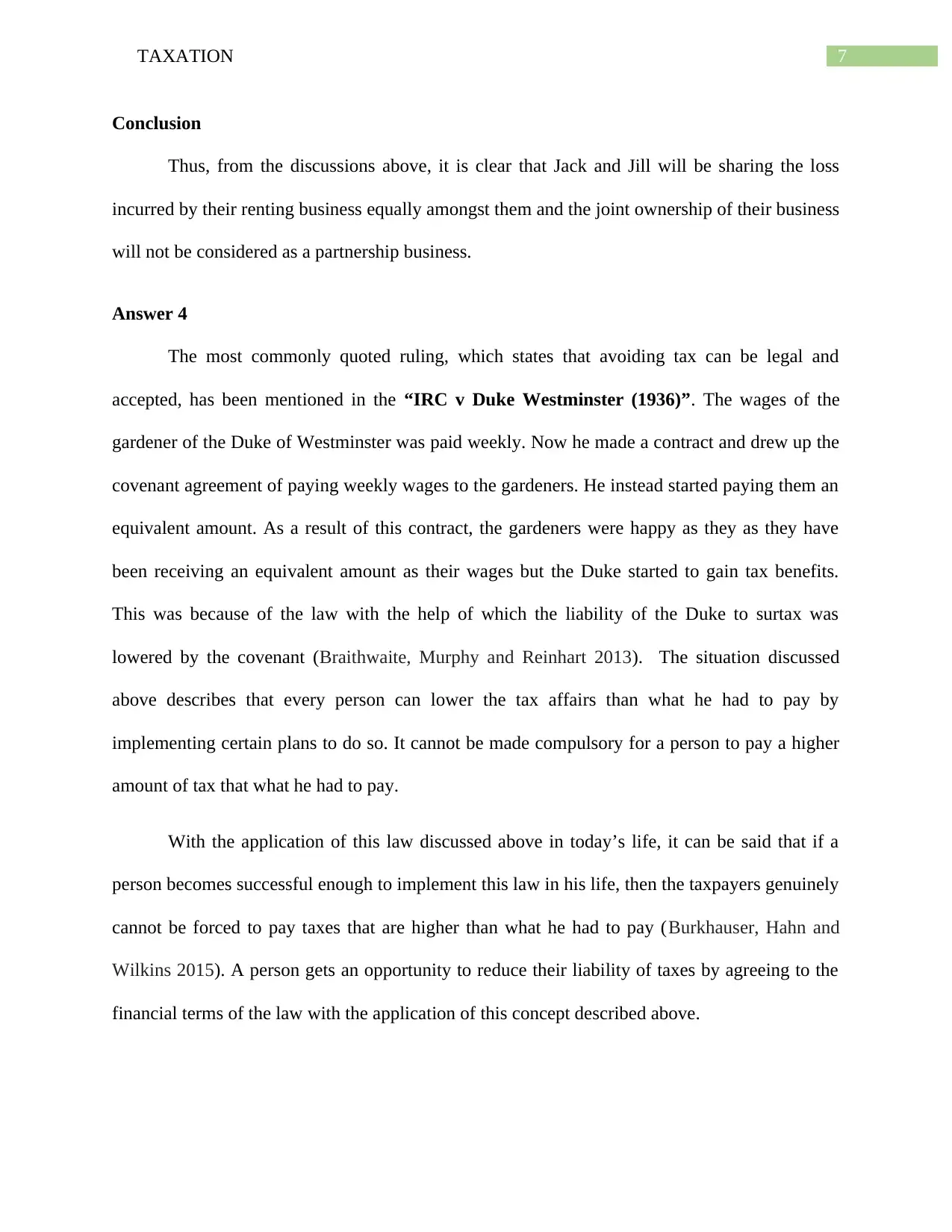
7TAXATION
Conclusion
Thus, from the discussions above, it is clear that Jack and Jill will be sharing the loss
incurred by their renting business equally amongst them and the joint ownership of their business
will not be considered as a partnership business.
Answer 4
The most commonly quoted ruling, which states that avoiding tax can be legal and
accepted, has been mentioned in the “IRC v Duke Westminster (1936)”. The wages of the
gardener of the Duke of Westminster was paid weekly. Now he made a contract and drew up the
covenant agreement of paying weekly wages to the gardeners. He instead started paying them an
equivalent amount. As a result of this contract, the gardeners were happy as they as they have
been receiving an equivalent amount as their wages but the Duke started to gain tax benefits.
This was because of the law with the help of which the liability of the Duke to surtax was
lowered by the covenant (Braithwaite, Murphy and Reinhart 2013). The situation discussed
above describes that every person can lower the tax affairs than what he had to pay by
implementing certain plans to do so. It cannot be made compulsory for a person to pay a higher
amount of tax that what he had to pay.
With the application of this law discussed above in today’s life, it can be said that if a
person becomes successful enough to implement this law in his life, then the taxpayers genuinely
cannot be forced to pay taxes that are higher than what he had to pay (Burkhauser, Hahn and
Wilkins 2015). A person gets an opportunity to reduce their liability of taxes by agreeing to the
financial terms of the law with the application of this concept described above.
Conclusion
Thus, from the discussions above, it is clear that Jack and Jill will be sharing the loss
incurred by their renting business equally amongst them and the joint ownership of their business
will not be considered as a partnership business.
Answer 4
The most commonly quoted ruling, which states that avoiding tax can be legal and
accepted, has been mentioned in the “IRC v Duke Westminster (1936)”. The wages of the
gardener of the Duke of Westminster was paid weekly. Now he made a contract and drew up the
covenant agreement of paying weekly wages to the gardeners. He instead started paying them an
equivalent amount. As a result of this contract, the gardeners were happy as they as they have
been receiving an equivalent amount as their wages but the Duke started to gain tax benefits.
This was because of the law with the help of which the liability of the Duke to surtax was
lowered by the covenant (Braithwaite, Murphy and Reinhart 2013). The situation discussed
above describes that every person can lower the tax affairs than what he had to pay by
implementing certain plans to do so. It cannot be made compulsory for a person to pay a higher
amount of tax that what he had to pay.
With the application of this law discussed above in today’s life, it can be said that if a
person becomes successful enough to implement this law in his life, then the taxpayers genuinely
cannot be forced to pay taxes that are higher than what he had to pay (Burkhauser, Hahn and
Wilkins 2015). A person gets an opportunity to reduce their liability of taxes by agreeing to the
financial terms of the law with the application of this concept described above.
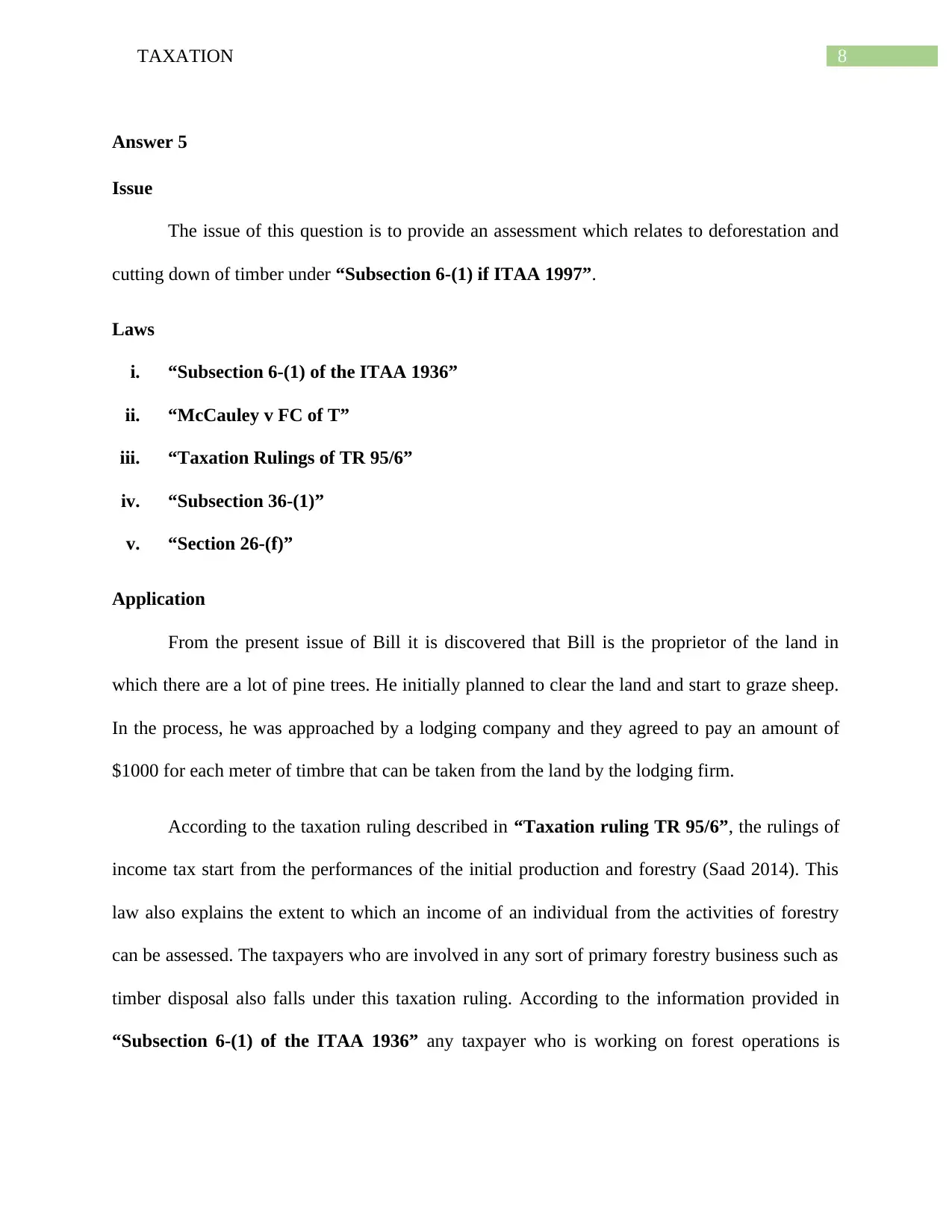
8TAXATION
Answer 5
Issue
The issue of this question is to provide an assessment which relates to deforestation and
cutting down of timber under “Subsection 6-(1) if ITAA 1997”.
Laws
i. “Subsection 6-(1) of the ITAA 1936”
ii. “McCauley v FC of T”
iii. “Taxation Rulings of TR 95/6”
iv. “Subsection 36-(1)”
v. “Section 26-(f)”
Application
From the present issue of Bill it is discovered that Bill is the proprietor of the land in
which there are a lot of pine trees. He initially planned to clear the land and start to graze sheep.
In the process, he was approached by a lodging company and they agreed to pay an amount of
$1000 for each meter of timbre that can be taken from the land by the lodging firm.
According to the taxation ruling described in “Taxation ruling TR 95/6”, the rulings of
income tax start from the performances of the initial production and forestry (Saad 2014). This
law also explains the extent to which an income of an individual from the activities of forestry
can be assessed. The taxpayers who are involved in any sort of primary forestry business such as
timber disposal also falls under this taxation ruling. According to the information provided in
“Subsection 6-(1) of the ITAA 1936” any taxpayer who is working on forest operations is
Answer 5
Issue
The issue of this question is to provide an assessment which relates to deforestation and
cutting down of timber under “Subsection 6-(1) if ITAA 1997”.
Laws
i. “Subsection 6-(1) of the ITAA 1936”
ii. “McCauley v FC of T”
iii. “Taxation Rulings of TR 95/6”
iv. “Subsection 36-(1)”
v. “Section 26-(f)”
Application
From the present issue of Bill it is discovered that Bill is the proprietor of the land in
which there are a lot of pine trees. He initially planned to clear the land and start to graze sheep.
In the process, he was approached by a lodging company and they agreed to pay an amount of
$1000 for each meter of timbre that can be taken from the land by the lodging firm.
According to the taxation ruling described in “Taxation ruling TR 95/6”, the rulings of
income tax start from the performances of the initial production and forestry (Saad 2014). This
law also explains the extent to which an income of an individual from the activities of forestry
can be assessed. The taxpayers who are involved in any sort of primary forestry business such as
timber disposal also falls under this taxation ruling. According to the information provided in
“Subsection 6-(1) of the ITAA 1936” any taxpayer who is working on forest operations is
⊘ This is a preview!⊘
Do you want full access?
Subscribe today to unlock all pages.

Trusted by 1+ million students worldwide
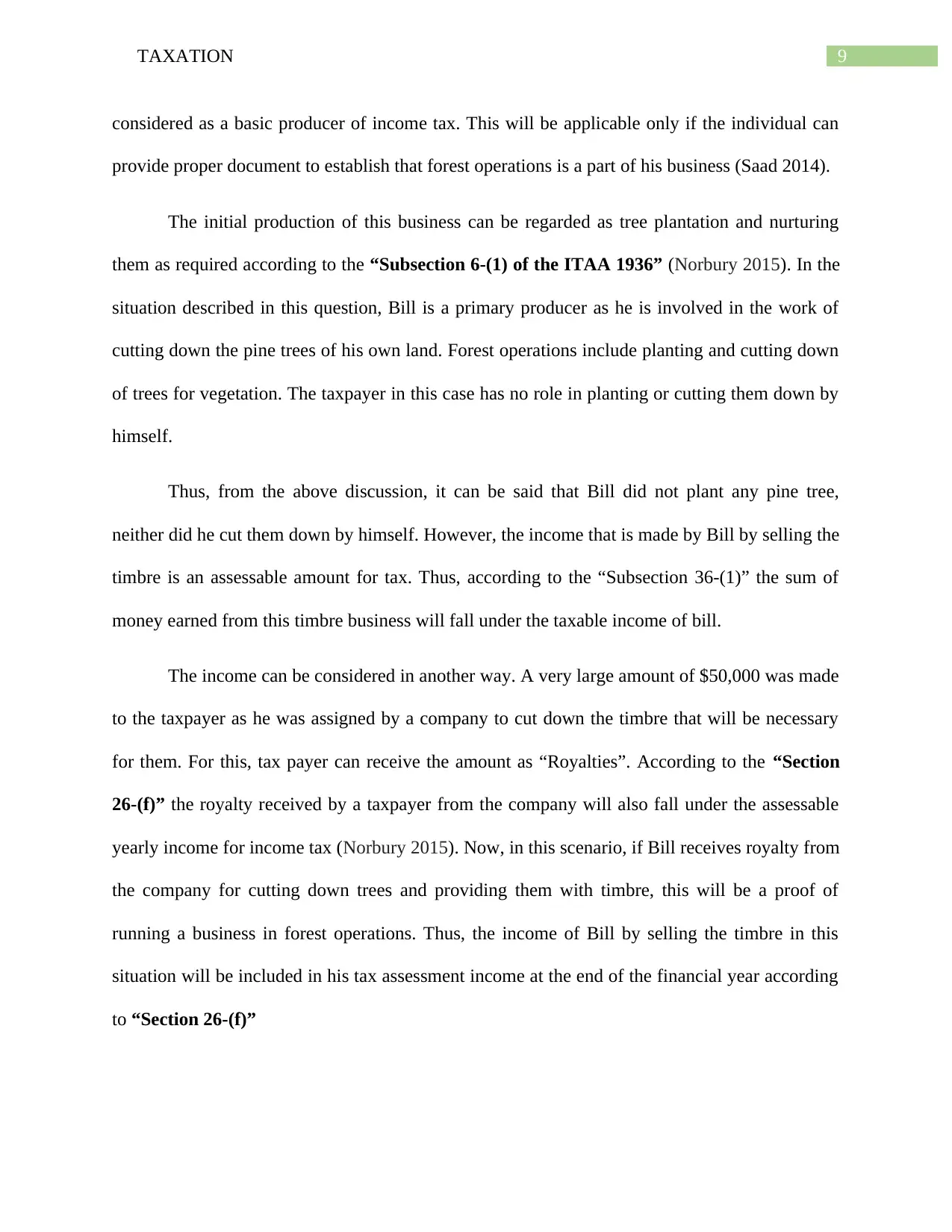
9TAXATION
considered as a basic producer of income tax. This will be applicable only if the individual can
provide proper document to establish that forest operations is a part of his business (Saad 2014).
The initial production of this business can be regarded as tree plantation and nurturing
them as required according to the “Subsection 6-(1) of the ITAA 1936” (Norbury 2015). In the
situation described in this question, Bill is a primary producer as he is involved in the work of
cutting down the pine trees of his own land. Forest operations include planting and cutting down
of trees for vegetation. The taxpayer in this case has no role in planting or cutting them down by
himself.
Thus, from the above discussion, it can be said that Bill did not plant any pine tree,
neither did he cut them down by himself. However, the income that is made by Bill by selling the
timbre is an assessable amount for tax. Thus, according to the “Subsection 36-(1)” the sum of
money earned from this timbre business will fall under the taxable income of bill.
The income can be considered in another way. A very large amount of $50,000 was made
to the taxpayer as he was assigned by a company to cut down the timbre that will be necessary
for them. For this, tax payer can receive the amount as “Royalties”. According to the “Section
26-(f)” the royalty received by a taxpayer from the company will also fall under the assessable
yearly income for income tax (Norbury 2015). Now, in this scenario, if Bill receives royalty from
the company for cutting down trees and providing them with timbre, this will be a proof of
running a business in forest operations. Thus, the income of Bill by selling the timbre in this
situation will be included in his tax assessment income at the end of the financial year according
to “Section 26-(f)”
considered as a basic producer of income tax. This will be applicable only if the individual can
provide proper document to establish that forest operations is a part of his business (Saad 2014).
The initial production of this business can be regarded as tree plantation and nurturing
them as required according to the “Subsection 6-(1) of the ITAA 1936” (Norbury 2015). In the
situation described in this question, Bill is a primary producer as he is involved in the work of
cutting down the pine trees of his own land. Forest operations include planting and cutting down
of trees for vegetation. The taxpayer in this case has no role in planting or cutting them down by
himself.
Thus, from the above discussion, it can be said that Bill did not plant any pine tree,
neither did he cut them down by himself. However, the income that is made by Bill by selling the
timbre is an assessable amount for tax. Thus, according to the “Subsection 36-(1)” the sum of
money earned from this timbre business will fall under the taxable income of bill.
The income can be considered in another way. A very large amount of $50,000 was made
to the taxpayer as he was assigned by a company to cut down the timbre that will be necessary
for them. For this, tax payer can receive the amount as “Royalties”. According to the “Section
26-(f)” the royalty received by a taxpayer from the company will also fall under the assessable
yearly income for income tax (Norbury 2015). Now, in this scenario, if Bill receives royalty from
the company for cutting down trees and providing them with timbre, this will be a proof of
running a business in forest operations. Thus, the income of Bill by selling the timbre in this
situation will be included in his tax assessment income at the end of the financial year according
to “Section 26-(f)”
Paraphrase This Document
Need a fresh take? Get an instant paraphrase of this document with our AI Paraphraser
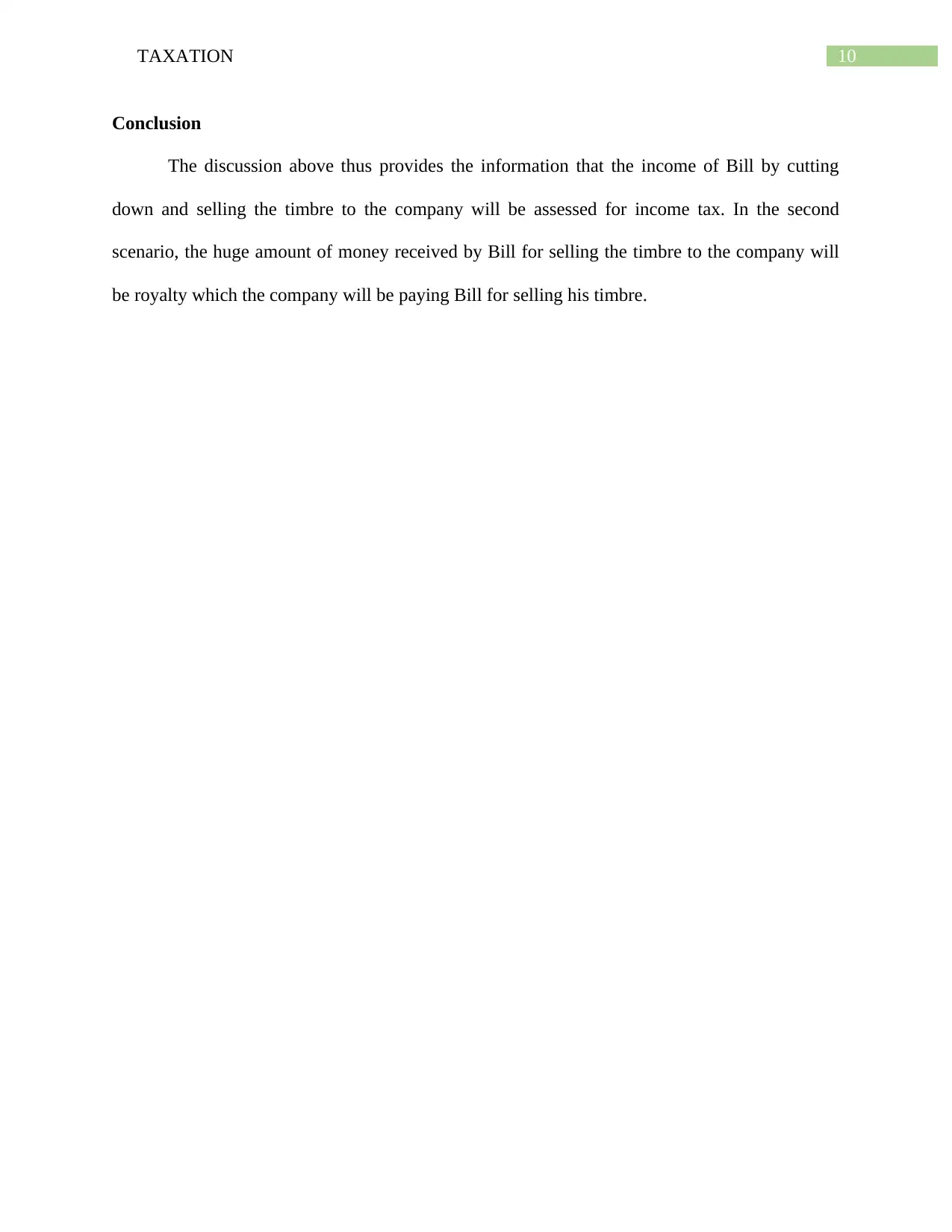
10TAXATION
Conclusion
The discussion above thus provides the information that the income of Bill by cutting
down and selling the timbre to the company will be assessed for income tax. In the second
scenario, the huge amount of money received by Bill for selling the timbre to the company will
be royalty which the company will be paying Bill for selling his timbre.
Conclusion
The discussion above thus provides the information that the income of Bill by cutting
down and selling the timbre to the company will be assessed for income tax. In the second
scenario, the huge amount of money received by Bill for selling the timbre to the company will
be royalty which the company will be paying Bill for selling his timbre.
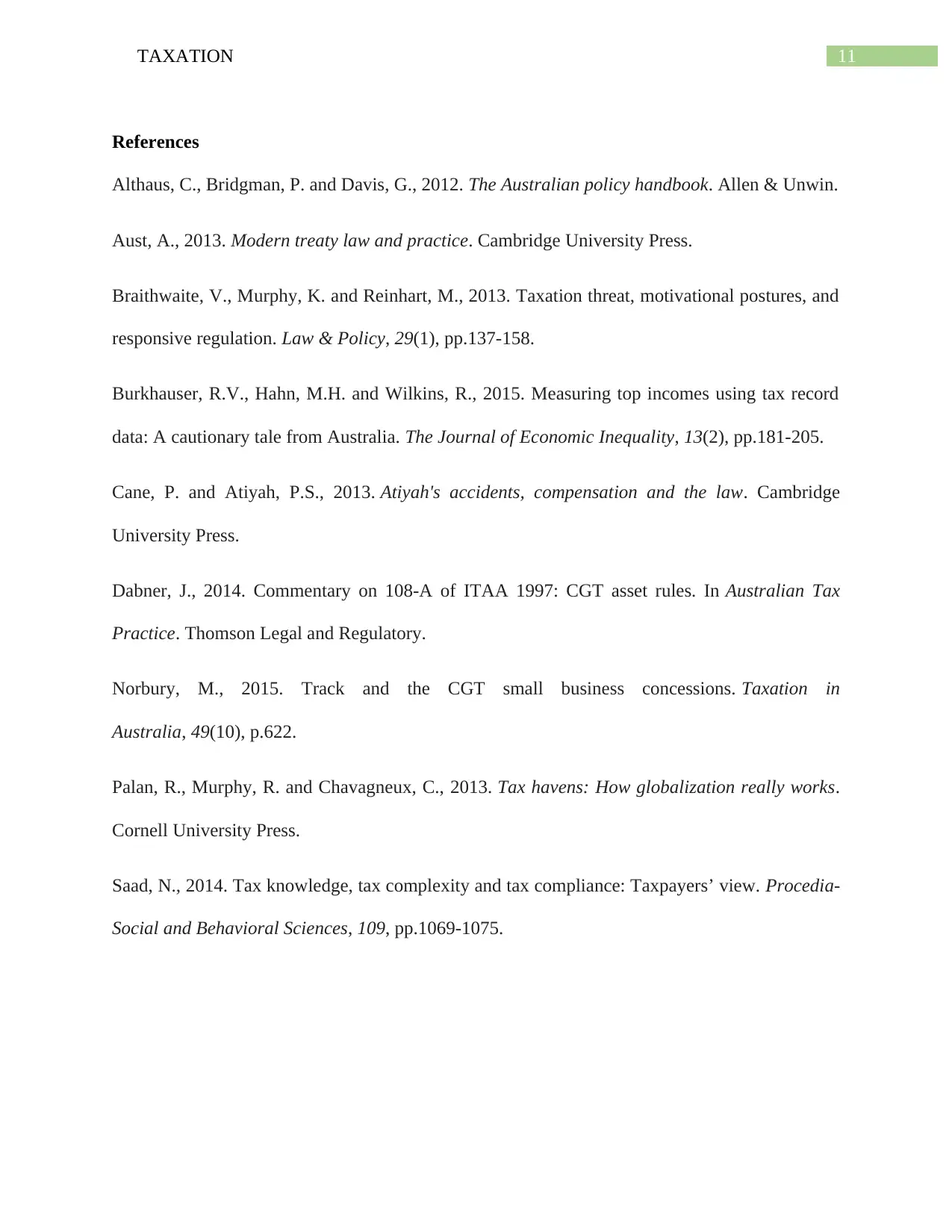
11TAXATION
References
Althaus, C., Bridgman, P. and Davis, G., 2012. The Australian policy handbook. Allen & Unwin.
Aust, A., 2013. Modern treaty law and practice. Cambridge University Press.
Braithwaite, V., Murphy, K. and Reinhart, M., 2013. Taxation threat, motivational postures, and
responsive regulation. Law & Policy, 29(1), pp.137-158.
Burkhauser, R.V., Hahn, M.H. and Wilkins, R., 2015. Measuring top incomes using tax record
data: A cautionary tale from Australia. The Journal of Economic Inequality, 13(2), pp.181-205.
Cane, P. and Atiyah, P.S., 2013. Atiyah's accidents, compensation and the law. Cambridge
University Press.
Dabner, J., 2014. Commentary on 108-A of ITAA 1997: CGT asset rules. In Australian Tax
Practice. Thomson Legal and Regulatory.
Norbury, M., 2015. Track and the CGT small business concessions. Taxation in
Australia, 49(10), p.622.
Palan, R., Murphy, R. and Chavagneux, C., 2013. Tax havens: How globalization really works.
Cornell University Press.
Saad, N., 2014. Tax knowledge, tax complexity and tax compliance: Taxpayers’ view. Procedia-
Social and Behavioral Sciences, 109, pp.1069-1075.
References
Althaus, C., Bridgman, P. and Davis, G., 2012. The Australian policy handbook. Allen & Unwin.
Aust, A., 2013. Modern treaty law and practice. Cambridge University Press.
Braithwaite, V., Murphy, K. and Reinhart, M., 2013. Taxation threat, motivational postures, and
responsive regulation. Law & Policy, 29(1), pp.137-158.
Burkhauser, R.V., Hahn, M.H. and Wilkins, R., 2015. Measuring top incomes using tax record
data: A cautionary tale from Australia. The Journal of Economic Inequality, 13(2), pp.181-205.
Cane, P. and Atiyah, P.S., 2013. Atiyah's accidents, compensation and the law. Cambridge
University Press.
Dabner, J., 2014. Commentary on 108-A of ITAA 1997: CGT asset rules. In Australian Tax
Practice. Thomson Legal and Regulatory.
Norbury, M., 2015. Track and the CGT small business concessions. Taxation in
Australia, 49(10), p.622.
Palan, R., Murphy, R. and Chavagneux, C., 2013. Tax havens: How globalization really works.
Cornell University Press.
Saad, N., 2014. Tax knowledge, tax complexity and tax compliance: Taxpayers’ view. Procedia-
Social and Behavioral Sciences, 109, pp.1069-1075.
⊘ This is a preview!⊘
Do you want full access?
Subscribe today to unlock all pages.

Trusted by 1+ million students worldwide
1 out of 12
Related Documents
Your All-in-One AI-Powered Toolkit for Academic Success.
+13062052269
info@desklib.com
Available 24*7 on WhatsApp / Email
![[object Object]](/_next/static/media/star-bottom.7253800d.svg)
Unlock your academic potential
Copyright © 2020–2025 A2Z Services. All Rights Reserved. Developed and managed by ZUCOL.





